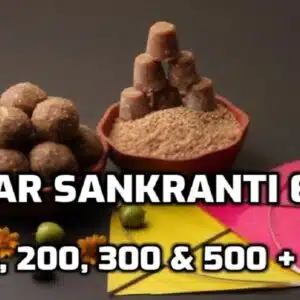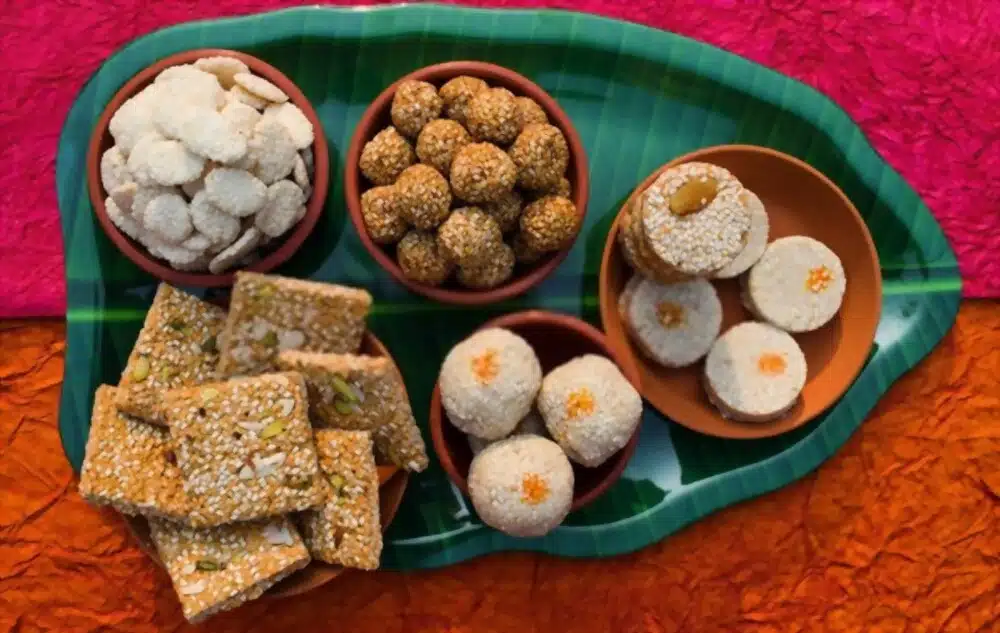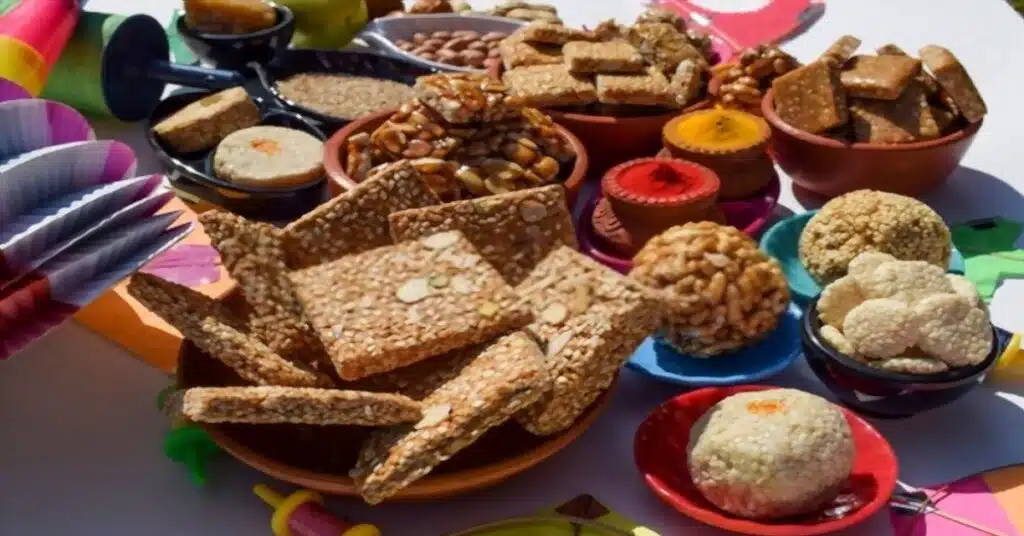
Makar Sankranti is celebrated on the 14th of January every year. This festival marks the transition of the sun into Capricorn (Makara) zodiac sign. It is a time when families come together to share sweets made from jaggery and sesame seeds and offer prayers to Lord Sun for his blessings. Let’s read 5 wonderful examples of Makar Sankranti Essay.
Makar Sankranti Essay – 100 words
Makar Sankranti is a fun festival celebrated in India. It’s full of joy and excitement. During this festival, we fly colorful kites in the sky. We also eat yummy sweets made from sesame seeds and jaggery. People take dips in rivers to get blessings and good luck. Makar Sankranti is celebrated in different ways in different parts of India. In Gujarat, people have a kite festival called “Uttarayan.” In Tamil Nadu, it’s called “Pongal” and they cook a special dish. In Assam, it’s called “Magh Bihu” and they have dances and feasts. Makar Sankranti is a time to have fun, be grateful for the harvest, and enjoy it with family and friends.
Also Read:
- Essay on Lohri Festival in English
- Paragraph on Holi
- A Paragraph on Christmas
- Paragraph on Diwali
- Essay on Quami Ekta Week in English
Makar Sankranti Essay -150 words
Makar Sankranti is a joyful and colorful festival celebrated in India. It is a special day when we say goodbye to winter and welcome longer days with lots of happiness. During this festival, we fly kites in the sky and have so much fun. The sky becomes a beautiful canvas filled with colorful kites of different shapes and sizes.
One of the best parts of Makar Sankranti is the yummy food we eat. We enjoy tasty sweets made from sesame seeds and jaggery. They are so delicious and make our taste buds happy.
Taking dips in rivers is also an important tradition during Makar Sankranti. It is believed to bring good luck and cleanse our souls. People gather at riversides to take these holy dips and offer prayers.
The skies come alive with a mass of vivid kites in different shapes and sizes. Families and friends gather on rooftops, flying kites, and engaging in friendly competitions. The atmosphere is filled with joyous laughter and spirited shouts of “Kai Po Che!” (meaning “I have cut!”) when someone successfully cuts the string of an opponent’s kite. The festival not only promotes a sense of unity and friendship but also showcases the artistic skills of kite-makers who craft complex designs and patterns.
Makar Sankranti is a time to have fun, enjoy delicious food, and celebrate with family and friends. It reminds us to be thankful for nature’s blessings and the warmth of the sun. Let’s cherish this festive spirit and make wonderful memories during Makar Sankranti.

Makar Sankranti Essay -200 words
Makar Sankranti is a joyous festival celebrated in India to mark the transition from winter to longer days. It is a time for embracing new beginnings and expressing gratitude for the abundant harvest and the blessings of the sun.
During Makar Sankranti, people partake in various traditions and customs. One popular activity is kite flying, where the sky is filled with colorful kites, creating a lively atmosphere of friendly competition and laughter.
Another delightful aspect of the festival is the preparation and sharing of special dishes. Families and friends come together to make delicious treats such as sesame and jaggery sweets, savory rice and lentil dishes, and various desserts made with sesame seeds.
Taking holy dips in rivers is considered auspicious during Makar Sankranti, as it is believed to cleanse the soul and bring good luck and blessings.
Makar Sankranti is celebrated in different ways across India. It is known as Uttarayan in Gujarat and is renowned for the International Kite Festival. Tamil Nadu celebrates it as Pongal, a harvest festival with cooking rituals and prayers. Assam calls it Magh Bihu, a time for feasts and traditional dances.
Makar Sankranti is a time of joy, celebration, and new beginnings. It brings people together, fosters cultural unity, and serves as a reminder of the importance of nature, the harvest, and the warmth of the sun in our lives.
Makar Sankranti Essay -300 words
Introduction:
Makar Sankranti is a vibrant and festive occasion celebrated in India, typically occurring in mid-January. This joyous festival holds great cultural and religious significance as it signifies the transition of the sun into the zodiac sign of Capricorn (Makar Rashi). Makar Sankranti marks the beginning of longer days and warmer weather, symbolizing new beginnings and fresh starts. In this essay, we will explore the various traditions and customs associated with Makar Sankranti, highlighting the significance of this festive celebration.
The Transition of the Sun: Makar Sankranti and its Cultural Significance
During Makar Sankranti, people bid farewell to winter and embrace longer days and warmer weather. This transition of the sun into the zodiac sign of Capricorn holds great cultural and religious significance. It is believed that this auspicious period brings blessings, prosperity, and positive energy. Makar Sankranti is a time when people express gratitude for the sun’s life-giving energy and its role in agricultural abundance.
Farewell to Winter, Embrace of New Days: Symbolizing Fresh Starts
Makar Sankranti signifies the end of winter and the beginning of a new phase. It is a festival that celebrates fresh starts and new opportunities. People clean their homes, wear new clothes, and participate in various traditional activities to welcome the new season. It is a time for rejuvenation, letting go of the past, and embracing a brighter future.
Flying Kites: Soaring High in a Canvas of Emotions and Competitions
One of the most popular traditions associated with Makar Sankranti is the flying of kites. People gather on rooftops or in open fields to fly kites of various shapes and sizes. The sky becomes a vibrant canvas as colorful kites soar high, creating an atmosphere filled with emotions and friendly competitions. The act of flying kites represents freedom, joy, and the desire to reach new heights in life.
Sweet Delights and Culinary Traditions: Sharing the Sweetness of Life
Makar Sankranti is also known for its delectable sweets and culinary traditions. People prepare and exchange treats made from sesame seeds, jaggery, and other ingredients. These traditional sweets symbolize the sweetness of life and the bonds of love. Sharing these treats with family, friends, and neighbors strengthens relationships and spreads joy during the festival.
Bonfires and Festive Warmth: Illuminating the Triumph of Light
Bonfires are an integral part of Makar Sankranti celebrations. People gather around these bonfires, which provide warmth and light to dispel the winter chill. They serve as a symbolic representation of the triumph of light over darkness. Traditional songs and dances accompany the bonfire gatherings, creating an atmosphere of joy and camaraderie.
Harvest Festival and Gratitude: Honoring the Bounty of the Earth
Makar Sankranti is not only a time of festivities but also a harvest festival. It is an opportunity for farmers to express gratitude for the plentiful harvest and offer prayers for a prosperous year ahead. The festival holds immense importance in rural communities, honoring the hard work and dedication of farmers. It is a time when communities come together to celebrate the abundance of nature and the blessings of the harvest.

Conclusion:
In conclusion, Makar Sankranti is a joyous festival that celebrates the transition of the sun into Capricorn, marking new beginnings and fresh starts. The festival encompasses various traditions, including flying kites, sharing sweets, lighting bonfires
Makar Sankranti Essay -500 words
Introduction
Makar Sankranti, also known as the “Festival of Harvest,” is one of India’s most beloved festivals. It marks the end of winter and the beginning of spring when the sun starts its journey northwards, towards the Tropic of Cancer. Celebrated with great enthusiasm and joy across India, this festival holds deep cultural significance for Hindus and is a time for family gatherings, feasting on delicious sweets and savories made from newly harvested crops, flying kites, and spreading love and happiness.
Let’s dive into the history behind Makar Sankranti, explore its significance in Indian culture, learn how it is celebrated across different parts of India and Nepal along with some interesting facts about this beautiful festival.
What is Makar Sankranti?
Makar Sankranti is a Hindu festival that marks the end of winter and the beginning of longer days. The word “Makar” refers to the zodiac sign Capricorn, and “Sankranti” means transition. This festival falls on January 14th every year but sometimes it can also fall on January 15th depending upon planetary movements.
The day coincides with when the sun enters into Makar Rashi or Capricorn marking the start of Uttarayan – a six-month period where the days are longer than nights. The significance of this auspicious occasion lies in its association with harvesting crops, as well as paying tribute to ancestors who have passed away.
People around India celebrate this auspicious day by making traditional sweets using jaggery and sesame seeds called til-gud laddoos, flying kites, taking holy dips in rivers like Ganga Sagar Mela at Sagar Island in Kolkata and offering prayers to Lord Sun for good health and prosperity.
In addition to India, Nepal celebrates Makar Sankranti by observing Ghya Chaku Sanlhu- a tradition similar to what we call Kite flying in India. People enjoy local delicacies made from rice flour during their celebrations.
Makar sankranti is an important celebration that signifies new beginnings while embracing traditions through food, prayers & festivals across cultures & borders alike!
The History of Makar Sankranti

Makar Sankranti is one of the most important Hindu festivals, celebrated in various parts of India and Nepal. The festival has a rich history that dates back to ancient times. It is believed that Makar Sankranti marks the day when Lord Sun enters into the zodiac sign of Capricorn or Makara, which represents a new beginning.
According to legend, on this day, King Bhagiratha brought the river Ganges from heaven to earth by performing intense penance for years. Thus, people take holy dips in rivers and offer prayers to Sun God on this day.
The festival also has agricultural significance as it marks the end of winter solstice and start of longer days. Farmers prepare for their next harvest season during Makar Sankranti by sowing crops like wheat and mustard.
In many parts of India, traditional sweets made with sesame seeds and jaggery are prepared as offerings to guests during this time. Kites flying is another popular activity associated with Makar Sankranti celebrated mainly in Gujarat and Rajasthan.
Makar Sankranti holds great cultural importance among Hindus all over India and Nepal due to its historical roots involving religion as well as agriculture practices.
The Significance of Makar Sankranti
Makar Sankranti is a significant festival that marks the transition of the sun into Capricorn (Makara) zodiac sign. This day falls on January 14th or 15th every year and holds immense importance in Hindu culture.
The significance of Makar Sankranti lies in its association with new beginnings, harvest season, and spiritual renewal. It symbolizes the end of winter and the arrival of spring, marking a time for growth and prosperity.
Moreover, it signifies unity among diversity as people from different regions come together to celebrate this festival with equal zeal. The day also holds religious significance as devotees take holy dips in rivers like Ganga, Yamuna, and Godavari to wash away their sins.
Another important aspect is food; traditional dishes made during Makar Sankranti are believed to bring good health and fortune. Sesame seeds-based sweets such as Til Ladoo or Chikki are consumed widely across India during this festive season.
In essence, Makar Sankranti is an occasion to express gratitude for nature’s bounty while embracing positivity and hope for better days ahead.
Celebrating Makar Sankranti
Celebrating Makar Sankranti is a joyful and vibrant affair in India. It is celebrated on the 14th of January every year when the Sun enters the zodiac sign Capricorn also known as Makar Rashi. This festival holds immense significance in Hindu culture, marking the start of longer days ahead after winter solstice.
On this day people wake up early to take a dip in holy rivers like Ganges, Yamuna, and Godavari to cleanse themselves from their sins. They offer prayers to Lord Surya or Sun God for blessings and prosperity by lighting lamps made out of sesame seeds and offering sweets made with jaggery.
Kite flying (patang baazi) has become an integral part of celebrating Makar Sankranti over time. People engage in kite-flying competitions with family and friends while enjoying traditional delicacies such as til chikki, gajak, puran poli, khichdi with desi ghee which are prepared especially for this occasion.
The celebration varies based on different regions across India but one thing that remains common is spreading happiness among all regardless of caste or religion. The spirit of unity during this festive season can be felt amongst everyone who takes part in it.
Makar Sankranti signifies new beginnings, hope for brighter days ahead filled with joyous moments spent together with loved ones making unforgettable memories!
Makar Sankranti in India

Makar Sankranti is one of the most popular festivals in India, celebrated with much enthusiasm and fervor across the country. In different parts of India, it is known by different names – Pongal in Tamil Nadu, Lohri in Punjab, Bihu in Assam and Uttarayan in Gujarat.
The festival marks the end of the winter solstice and beginning of longer days. It is also an important spiritual occasion when people take a dip into holy rivers such as Ganga to cleanse their sins. The day also signifies a new harvest season for farmers.
In Maharashtra, Makar Sankranti celebrations are incomplete without indulging in til-gul ladoos made from sesame seeds and jaggery. In other parts of India like Gujarat, flying kites on this day has become a traditional activity during which whole families come together to enjoy each other’s company.
Makar Sankranti brings joyous moments for everyone celebrating this vibrant festival.
Makar Sankranti in Nepal
Makar Sankranti is celebrated not only in India but also in Nepal with great enthusiasm. In Nepal, this festival is known as Maghe Sankranti or Maghi and it marks the beginning of the auspicious month of Magh. Nepalese people celebrate this festival by taking a holy dip at sacred rivers like Bagmati, Narayani, and Koshi.
On this day, people wear new clothes and enjoy traditional food such as ghee-based sweets called Chaku and Til ko Laddu made from sesame seeds. In addition to that, kite flying is also a popular activity during Makar Sankranti in Nepal just like in India.
Moreover, on this day Hindus pay their respect to Lord Vishnu by visiting his temples like Gokarneshwar Mahadev Temple, Budhanilkantha Temple or Pashupatinath Temple where devotees participate in special prayers dedicated to Lord Vishnu.
Makar Sankranti in Nepal has its unique way of celebration that showcases the cultural diversity within South Asia.
Conclusion
Makar Sankranti is a festival that holds immense significance in Indian culture and traditions. Celebrated annually on the 14th of January, it marks the beginning of a new season and symbolizes the transition from darkness to light. From flying kites to taking holy dips, Makar Sankranti is celebrated with great enthusiasm across India and Nepal.
This festival not only brings people together but also promotes harmony among different communities. It spreads happiness, love, and positivity all around. The vibrant colors and delicious delicacies associated with this festival make it even more joyous.
Makar Sankranti is an auspicious occasion that brings prosperity, good health, and happiness into our lives. Let us celebrate this beautiful festival by spreading love and warmth among each other while embracing our rich cultural heritage!
FAQs
1. Why Do we celebrate Makar Sankranti?
Makar Sankranti is celebrated for various reasons. One of the main reasons is that it marks the end of winter and the beginning of longer days. It is a time to welcome the arrival of spring and new beginnings.
Another significant reason behind celebrating Makar Sankranti is to express gratitude for the bountiful harvest. This festival is closely associated with agriculture, as it falls at a time when crops are harvested
Makar Sankranti also holds religious and spiritual significance. It is believed that taking holy dips in sacred rivers during this time cleanses one’s sins and brings blessings and good fortune.
2. Which color should I wear on Makar Sankranti?
On Makar Sankranti, it is traditional to wear an energetic and colorful dress. The festival is associated with joy, enthusiasm, and celebration. While there is no specific color that is mandatory to wear, people often choose bright shades like yellow, orange, red, and green. These colors represent the cheerfulness of the harvest season and add to the festive spirit. However, feel free to choose any color that sounds with you and makes you feel joyful during this amazing festival.
3. Is Makar Sankranti a Hindu festival?
Yes, Makar Sankranti is primarily a Hindu festival. It is celebrated in India. It holds significant cultural and religious importance within the Hindu community. The festival is observed to mark the transition of the sun into the zodiac sign of Capricorn (Makar Rashi) and is based on the Hindu solar calendar. However, it is worth mentioning that Makar Sankranti is also celebrated by other communities and regions in India with their own unique customs and traditions.
4. Is Makar Sankranti a festival of Shiva?
No, Makar Sankranti is not specifically a festival dedicated to Lord Shiva. It is a festival that primarily celebrates the transition of the sun into the zodiac sign of Capricorn (Makar Rashi) and is associated with the harvest season. While Lord Shiva is worshiped in Hinduism, Makar Sankranti itself is not directly linked to Lord Shiva’s worship or mythology. However, devotees may choose to offer prayers to Lord Shiva or other deities during the festival, depending on their personal beliefs and traditions.
5. What is the significance of sesame seeds on Makar Sankranti (Kite Festival)?
Sesame seeds hold great significance on Makar Sankranti, which is also known as the Kite Festival. Sesame seeds, commonly known as “til” in Hindi, play an important role in the celebrations and rituals of this festival.
Here are a few reasons why sesame seeds are significant:
- Symbol of Good Luck: Sesame seeds are considered favorable and are believed to bring good luck and prosperity. They symbolize wealth and richness, which are essential elements during the harvest season.
- Traditional Sweets: Sesame seeds are a key ingredient in many traditional sweets prepared during Makar Sankranti. Sweets like tilgur and til chikki are popular and widely distributed among friends, family, and neighbors during the festival.
- Health Benefits: Sesame seeds are rich in nutrients and have numerous health benefits. They are a good source of essential minerals, healthy fats, and antioxidants. Consuming sesame seeds during Makar Sankranti is believed to provide warmth and nourishment during the winter season.
- Offering to Ancestors: In some regions, sesame seeds are offered as a symbolic offering to ancestors. It is believed that by offering sesame seeds, one can seek blessings from departed loved ones and ancestors.
- Kite Flying Tradition: Sesame seeds are used to make the “manja,” a special thread coated with a mixture of glue and crushed sesame seeds that is used to fly kites during the festival. The sticky manja allows kite flyers to cut the strings of other kites, adding excitement and competition to the festivities.
Overall, sesame seeds hold cultural, delicious, and symbolic significance during Makar Sankranti. They add flavor to traditional sweets, symbolize good luck and prosperity, and enhance the joyous atmosphere of kite flying.
6. Is Makar Sankranti known as ‘one festival with many names’?
Makar Sankranti is often referred to as ‘one festival with many names’ because it is celebrated under different names and with varying customs and traditions across different regions of India. The festival signifies the transition of the sun into the zodiac sign of Capricorn (Makar Rashi), and it holds immense cultural and religious significance. Here are a few reasons why Makar Sankranti is known by multiple names:
Regional Variations: India is a diverse country with distinct regional cultures and languages. Each region has its own unique way of celebrating Makar Sankranti. This festival is also known by different names in different states. For example, it is called “Pongal”in Tamil Nadu, “Lohri” in Punjab, “Bihu” in Assam, “Uttarayan” in Gujarat, and “Magh Bihu” in West Bengal and Assam
Harvest Festival: Makar Sankranti is primarily a harvesting festival, and various communities and agricultural regions celebrate the harvest season with different names and customs. The festival marks the end of the winter session and the beginning of longer days, which are favorable for agricultural activities.
Cultural Diversity: India’s cultural diversity is reflected in the hundreds of names and customs associated with Makar Sankranti. The festival is deeply rooted in the local traditions and beliefs of each region, highlighting the cultural richness and heritage of the country.
Rituals and Customs: Along with different names, Makar Sankranti is also celebrated with distinct rituals and customs in various regions. Each community adds its own unique flavor to the festival, making it a colorful and diverse celebration throughout the country.
By being known as ‘one festival with many names,’ Makar Sankranti showcases the unity in diversity and the colorful tapestry of traditions and cultures across India. It emphasizes the shared nature of celebrating the transition of the sun and the harvest season while embracing the unique regional flavors and customs of each community.